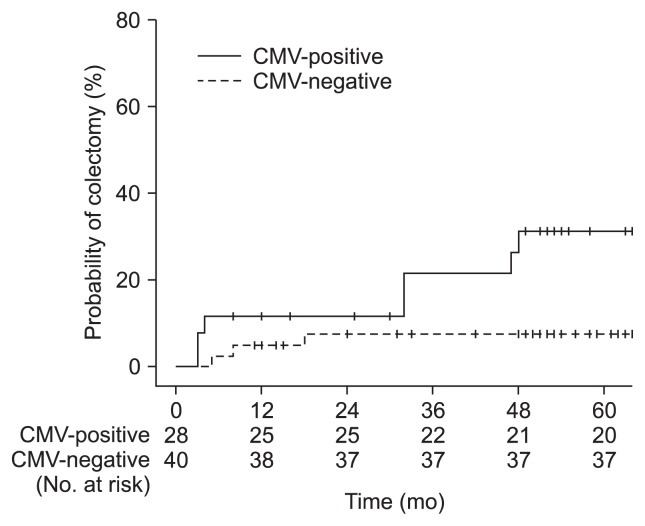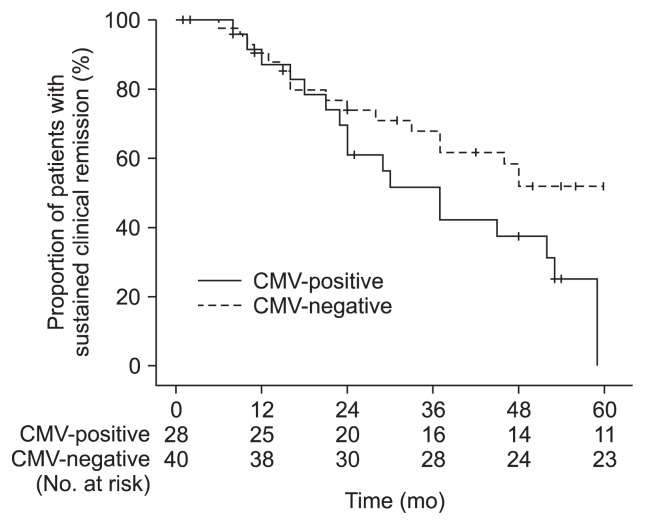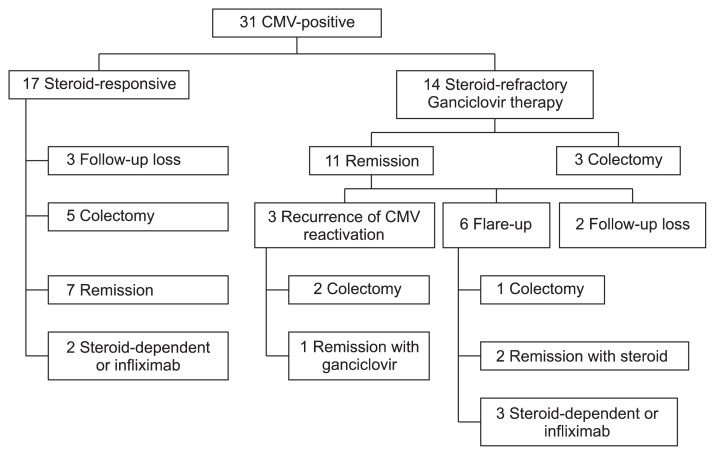Abstract
Background/Aims
Cytomegalovirus (CMV) reactivations are frequently observed in patients with active ulcerative colitis (UC), and ganciclovir therapy is effective in patients with steroid-refractory UC. This study aimed to determine the long-term outcomes of CMV reactivation and the long-term therapeutic efficacy of ganciclovir treatment.
Methods
This retrospective multicenter study included a cohort of 72 patients with moderate-to-severe UC who were evaluated for CMV reactivation at the time of their initial UC flare. Colectomy, disease relapse, and the recurrence rate of CMV reactivation were investigated.
Results
The mean duration of follow-up for the 72 patients was 43.16±19.78 months (range, 1 to 67 months). The cumulative colectomy (log-rank, p=0.025) and disease flare-up rates (log-rank, p=0.048) were significantly higher in the CMV-positive group. Of the 11 patients who were successfully treated with ganciclovir in the initial treatment, three patients (27.3%) experienced CMV reactivation, and six patients (54.5%) experienced poor outcomes, such as the need for colectomy or a steroid-dependent state.
Conclusions
The patients who had CMV-reactivated UC showed poor outcomes at the long-term follow-up, and the long-term efficacy of ganciclovir therapy was marginal. Careful assessment is necessary for patients who exhibit evidence of CMV reactivation.
Keywords: Colitis, ulcerative, Cytomegalovirus, Ganciclovir, Colectomy
INTRODUCTION
Human cytomegalovirus (CMV) is a member of Herpesviridae family and is ubiquitous in the environment. After a primary asymptomatic infection, CMV has a lifelong latency.1,2 Proinflammatory cytokines (tumor necrosis factor-α or interferon-γ) can induce active CMV replication and migration to inflamed tissue.3,4 Patients with inflammatory bowel disease (IBD) are at a high risk of CMV reactivation. Two factors that are involved in CMV reactivation in patients with IBD are an inherent factor of disease severity and an iatrogenic factor of immunosuppressive medication.5
Recent prospective studies have shown that CMV infection in patients with IBD is associated with poor outcomes.6–10 In our previous study,10 we reported that CMV reactivation is frequently observed in patients with moderate to severe ulcerative colitis (UC), especially in patients with steroid-refractory UC. Ganciclovir has also been shown to be an effective treatment for steroid-refractory UC in patients who had CMV reactivation. Although many clinicians have the opinion that the long-term clinical outcomes of IBD patients with reactivated CMV infection are unfavorable, there is only one report on the long-term clinical outcomes of CMV infection in IBD patients.11 Moreover, the long-term efficacy of ganciclovir therapy in patients with UC has not yet been determined. Therefore, in this study, we evaluated the long-term clinical outcomes of a cohort of patients with active UC for CMV evaluation, focusing on the cumulative colectomy and remission maintenance rates.
MATERIALS AND METHODS
1. Patients
Seventy-two consecutive patients were enrolled prospectively between July 2007 and December 2008 from 10 referral medical centers in Korea in the CMV cohort.10 Initially, the incidence of CMV reactivation and the clinical efficacy of ganciclovir were evaluated in this cohort. The patients included in this cohort were hospitalized, with a Mayo Clinic score between 8 and 12. In addition, only patients with left-sided or extensive colitis were enrolled. The 72 patients were grouped into a CMV-positive (n=31) and CMV-negative group (n=41) according to the results of CMV assessment at the initial UC flare-up. The baseline characteristic of these two groups showed no differences in respects with age, sex, disease duration, extent of disease, initial disease activity index, endoscopic grade, and previous treatment with azathioprine.10 Cumulative colectomy, disease relapse, and recurrence of CMV reactivation rates were investigated retrospectively from 2 months after initial flare-up to January 2013. The Institutional Ethics Committee of each institute approved the study protocol.
2. Criteria for the diagnosis of CMV reactivation
The presence of CMV was defined as serologic detection of CMV IgM antibody or histologic detection of inclusion bodies on hematoxylin and eosin-stained sections, positive immunohistochemical staining, or CMV DNA amplification by polymerase chain reaction. Any positive results were regarded as evidence of CMV reactivation.
3. Statistical analysis
Data are expressed as mean±standard deviation. Categorical data were compared using a chi-square test (Fisher exact test). The Kaplan-Meier method was used for cumulative colectomy and remission maintenance rates, and differences between CMV-positive and CMV-negative groups were analyzed using the log-rank test. Statistical analysis was performed using the SPSS package for Windows version 18.0 (SPSS Inc., Chicago, IL, USA). A two-tailed p-value <0.05 was considered to be statistically significant.
RESULTS
1. Patient follow-up
The mean duration of follow-up was 43.16±19.78 months (range, 1 to 67 months). Of the 72 patients, 11 (15.3%) had not been followed-up in January 2013, approximately a 5-year period. Five patients (16.1%) from the CMV-positive group dropped out during the follow-up period and six (14.6%) from the CMV-negative group dropped out (p=0.861).
2. The cumulative colectomy rate
In the CMV-positive group, a total of 11 patients (35.3%) underwent colectomy at the time of their initial flare-up (three patients) or during the follow-up period (eight patients). Meanwhile, four patients (9.8%) underwent colectomy in the CMV-negative group at the time of their initial flare-up (one patient) or during the follow-up period (three patients). The cumulative colectomy rate was significantly higher in the CMV-positive group than in the CMV-negative group (log rank, p=0.025) (Fig. 1).
Fig. 1.
Kaplan-Meier estimation of the cumulative colectomy rates of the cytomegalovirus (CMV)-positive and CMV-negative groups with moderate-to-severe ulcerative colitis. The CMV-positive group (n=8) had a significantly higher colectomy rate compared with the CMV-negative group (n=3) during long-term follow-up (log-rank, p=0.025).
3. The sustained clinical remission rate
After the initial flare, 28 patients in the CMV-positive group and 40 patients in the CMV-negative group entered clinical remission. However, many patients presented with several times of flare-up after the initial remission and during the approximately 5-year follow-up period. Overall, the sustained clinical remission rate was significantly lower in the CMV-positive group than in the CMV-negative group (log rank, p=0.048) (Fig. 2).
Fig. 2.
Kaplan-Meier estimation of the sustained clinical remission rate between the cytomegalovirus (CMV)-positive and CMV-negative groups with moderate-to-severe ulcerative colitis. The CMV-positive group showed a significantly lower sustained clinical remission rate during the follow-up period compared with the CMV-negative group (p=0.048).
4. CMV reactivation rate
Six patients (8.3%) showed evidence of CMV reactivation during the follow-up period; three were from the CMV-negative group (7.3%) and were treated successfully with ganciclovir therapy, and three were from the CMV-positive group (9.7%) (p=0.720). These three patients in the CMV-positive group were treated successfully with ganciclovir initially; however, they experienced the recurrences of CMV reactivation at the 1-year (one patient) and 2-year (two patients) follow-up periods. CMV reactivation after successful ganciclovir therapy was not uncommon (27.3%).
5. Outcomes of ganciclovir therapy
Of the 11 patients who were successfully treated with ganciclovir for their initial flare-up, three patients (27.3%) experienced a CMV reactivation. Despite repeated treatment with ganciclovir, two patients eventually underwent colectomy owing to a poor response to ganciclovir. Six patients (54.5%) experienced another disease flares, one patient underwent colectomy, three patients became steroid dependent and started on infliximab, and two patients entered remission after steroid treatment. Another two patients dropped-out at the 1-year (one patient) and 2-year (one patient) follow-ups. Therefore, among nine patients who were still enrolled in the study at the approximately 5-year follow-up, six patients (66.7%) showed a poor outcome such as colectomy or a steroid-dependent state (Fig. 3). Among the patients who had the evidence of CMV reactivation, but improved with steroid treatment at initial flare, five patients underwent colectomy eventually during follow-up periods.
Fig. 3.
Clinical long-term outcomes in patients with moderate-to-severe ulcerative colitis who exhibited evidence of cytomegalovirus (CMV) reactivation at the time of the initial flare-up.
DISCUSSION
The CMV infection rate is reported as 40% to 100% of the worldwide adult population.1,2 The prevalence of CMV infection appears to be higher in developing countries, as the transmission of CMV is through close personal contact. In Korea, laboratory evidence of prior infection of CMV (CMV IgG) in the year 2000 was reported in 92% of the general population.12 A recent study of the Chinese population reported the prevalence of CMV IgG in Chinese IBD patients to be 76.11%.13 Therefore, we believe that CMV reactivation is more frequent in Asian IBD patients than in Western patients, and clinicians in Asian countries should pay more attention to CMV reactivation in IBD patients.
Most cases of CMV reactivation in patients with IBD occur in those treated with steroids and/or immunosuppressants. However, several studies suggested that disease severity itself plays an important role in CMV reactivation. Dimitroulia et al.14 reported that detection of the CMV genome in intestinal tissue is 20 times more likely in UC patients than in controls. Additionally, the CMV genome was detected more frequently in patients with severe UC than mild to moderate UC. In addition, several studies identified CMV reactivation in steroid-naive UC patients,15,16 indicating that severe inflammation of colonic mucosa triggered the reactivation of CMV. Our previous study also showed that three of 65 patients (4.5%) with newly diagnosed, moderate to severe UC had evidence of CMV infection,17 although they did not received any steroid or immunosuppressant therapy. These results suggest that severe colonic inflammation itself is an important trigger for CMV reactivation. Moreover, the natural course of UC in patients with CMV reactivation might be worse than that in CMV negative patients, because severe inflammation itself can cause a poor outcome.18 These suggestions are in concordance with the long-term outcomes of our study. In the CMV-positive group, the cumulative colectomy rate over 43.16 months was significantly higher compared to that in the CMV-negative group (log rank, p=0.025). In addition, the cumulative disease relapse rate was significantly higher in CMV-positive group (log rank, p=0.048). A recent study demonstrated similar results; their colectomy rate was significantly higher in patients with IBD and CMV (29%) compared with the control group of patients with IBD but no CMV (11.2%) (p=0.007) over a 10-year observation period.11 They suggested that the presence of CMV in patients with IBD may increase the risk of colectomy, although the mechanism is not yet clear. In addition, Park et al.19 reported that a history of CMV reactivation within 3 months prior to infliximab treatment acted as an independent positive predictor of nonresponse to infliximab. It is still unclear how CMV reactivation causes the refractory response to steroid or infliximab treatment in UC.
The European Crohn’s and Colitis Organization (ECCO) guidelines currently recommend the use of antiviral therapy for CMV infection complicating UC.20 In our previous study, we treated 14 patients with UC who were steroid-refractory and had evidence of CMV reactivation with ganciclovir, and 11 (79%) improved.10 These 11 patients avoided the need for colectomy in the short-term. However, the long-term outcome of these patients showed a marginal efficacy of antiviral therapy. Among the nine patients who gave clinical information at the end-point of the study, six (66.7%) presented with an unfavorable outcome such as colectomy or a steroid-dependent state. These results show that despite successful treatment with ganciclovir in the short-term, patients with UC and reactivated CMV infection should be managed carefully to avoid poor long-term outcomes. CMV reactivation occurred in 27.3% of patients who had successful treatment with ganciclovir. Al-Zafiri et al.11 reported that no significant difference in outcomes were noted with antiviral therapy in IBD patients with CMV. However, our data showed that antiviral therapy was clearly effective in the short-term and was effective in the long-term in half of the patients. UC patients with CMV reactivation tend to have severe colonic inflammation, and this inherent factor could affect the long-term clinical outcomes, such as colectomy.18 Moreover, it is clear that the presence of CMV is associated with the severity of colitis and an increased risk of colectomy.21
Our study has several limitations. First, we did not provide strict protocols for the long-term assessment of CMV in the cohort of patients with active UC. After the initial flare-up and CMV evaluation, the patients were followed-up at 10 participating centers. Therefore, there may have been some heterogeneities in observation and treatment strategies among the centers. However, we wanted to observe the natural course of UC patients with reactivated CMV infection. Secondly, the size of the patient cohort was relatively small, and 11 patients dropped-out during the follow-up period. The drop-out rate of patients showed no difference between CMV-positive and CMV-negative groups (p=0.861). It is postulated that these 11 patients might have a good clinical course; they would have visited a participating center if the patients experienced a flare-up.
In conclusion, patients with UC who experienced reactivation of CMV infection showed poor outcomes at long-term follow-up. This group had a higher rate of colectomy and had more frequent disease flare-ups. Although the short-term efficacy of ganciclovir treatment was favorable, the long-term efficacy was marginal. Therefore, careful monitoring is necessary for patients with moderate to severe UC who have evidence of CMV reactivation.
ACKNOWLEDGEMENTS
This study was supported by a grant of the Korean Health Technology R&D Project, Ministry of Health and Welfare, Republic of Korea (A120176).
Footnotes
This study was presented at the First Asian Organization for Crohn’s and Colitis Symposium on June 13, 2013 (Tokyo, Japan).
CONFLICTS OF INTEREST
No potential conflict of interest relevant to this article was reported.
REFERENCES
- 1.de Jong MD, Galasso GJ, Gazzard B, et al. Summary of the II International Symposium on Cytomegalovirus. Antiviral Res. 1998;39:141–162. doi: 10.1016/S0166-3542(98)00044-8. [DOI] [PubMed] [Google Scholar]
- 2.Goodgame RW. Gastrointestinal cytomegalovirus disease. Ann Intern Med. 1993;119:924–935. doi: 10.7326/0003-4819-119-9-199311010-00010. [DOI] [PubMed] [Google Scholar]
- 3.Soderberg-Naucler C. Human cytomegalovirus persists in its host and attacks and avoids elimination by the immune system. Crit Rev Immunol. 2006;26:231–264. doi: 10.1615/CritRevImmunol.v26.i3.30. [DOI] [PubMed] [Google Scholar]
- 4.Söderberg-Nauclér C, Fish KN, Nelson JA. Interferon-gamma and tumor necrosis factor-alpha specifically induce formation of cytomegalovirus-permissive monocyte-derived macrophages that are refractory to the antiviral activity of these cytokines. J Clin Invest. 1997;100:3154–3163. doi: 10.1172/JCI119871. [DOI] [PMC free article] [PubMed] [Google Scholar]
- 5.Nguyen M, Bradford K, Zhang X, Shih DQ. Cytomegalovirus reactivation in ulcerative colitis patients. Ulcers. 2011 doi: 10.1155/2011/282507. pii: 282507. [DOI] [PMC free article] [PubMed] [Google Scholar]
- 6.Domènech E, Vega R, Ojanguren I, et al. Cytomegalovirus infection in ulcerative colitis: a prospective, comparative study on prevalence and diagnostic strategy. Inflamm Bowel Dis. 2008;14:1373–1379. doi: 10.1002/ibd.20498. [DOI] [PubMed] [Google Scholar]
- 7.Wada Y, Matsui T, Matake H, et al. Intractable ulcerative colitis caused by cytomegalovirus infection: a prospective study on prevalence, diagnosis, and treatment. Dis Colon Rectum. 2003;46:S59–S65. doi: 10.1097/01.DCR.0000087486.21981.C6. [DOI] [PubMed] [Google Scholar]
- 8.Criscuoli V, Casà A, Orlando A, et al. Severe acute colitis associated with CMV: a prevalence study. Dig Liver Dis. 2004;36:818–820. doi: 10.1016/j.dld.2004.05.013. [DOI] [PubMed] [Google Scholar]
- 9.Cottone M, Pietrosi G, Martorana G, et al. Prevalence of cytomegalovirus infection in severe refractory ulcerative and Crohn’s colitis. Am J Gastroenterol. 2001;96:773–775. doi: 10.1111/j.1572-0241.2001.03620.x. [DOI] [PubMed] [Google Scholar]
- 10.Kim YS, Kim YH, Kim JS, et al. The prevalence and efficacy of ganciclovir on steroid-refractory ulcerative colitis with cytomegalovirus infection: a prospective multicenter study. J Clin Gastroenterol. 2012;46:51–56. doi: 10.1097/MCG.0b013e3182160c9c. [DOI] [PubMed] [Google Scholar]
- 11.Al-Zafiri R, Gologan A, Galiatsatos P, Szilagyi A. Cytomegalovirus complicating inflammatory bowel disease: a 10-year experience in a community-based, university-affiliated hospital. Gastroenterol Hepatol (N Y) 2012;8:230–239. [PMC free article] [PubMed] [Google Scholar]
- 12.Kim O, Kim SS, Choi BS, et al. Consistency of the low seroprevalence of human herpesvirus 8 and the rarity of Kaposi’s sarcoma in South Korea. J Bacteriol Virol. 2001;31:275–279. [Google Scholar]
- 13.Yi F, Zhao J, Luckheeram RV, et al. The prevalence and risk factors of cytomegalovirus infection in inflammatory bowel disease in Wuhan, Central China. Virol J. 2013;10:43. doi: 10.1186/1743-422X-10-43. [DOI] [PMC free article] [PubMed] [Google Scholar]
- 14.Dimitroulia E, Spanakis N, Konstantinidou AE, Legakis NJ, Tsakris A. Frequent detection of cytomegalovirus in the intestine of patients with inflammatory bowel disease. Inflamm Bowel Dis. 2006;12:879–884. doi: 10.1097/01.mib.0000231576.11678.57. [DOI] [PubMed] [Google Scholar]
- 15.Inoue K, Wakabayashi N, Fukumoto K, et al. Toxic megacolon associated with cytomegalovirus infection in a patient with steroid-naïve ulcerative colitis. Intern Med. 2012;51:2739–2743. doi: 10.2169/internalmedicine.51.8145. [DOI] [PubMed] [Google Scholar]
- 16.Pfau P, Kochman ML, Furth EE, Lichtenstein GR. Cytomegalovirus colitis complicating ulcerative colitis in the steroid-naive patient. Am J Gastroenterol. 2001;96:895–899. doi: 10.1111/j.1572-0241.2001.03672.x. [DOI] [PubMed] [Google Scholar]
- 17.Kim YS, Kim YH, Kim JS, et al. Cytomegalovirus infection in patients with new onset ulcerative colitis: a prospective study. Hepatogastroenterology. 2012;59:1098–1101. doi: 10.5754/hge10217. [DOI] [PubMed] [Google Scholar]
- 18.Nakase H, Honzawa Y, Toyonaga T, et al. Diagnosis and treatment of ulcerative colitis with cytomegalovirus infection: importance of controlling mucosal inflammation to prevent cytomegalovirus reactivation. Intest Res. 2014;12:5–11. doi: 10.5217/ir.2014.12.1.5. [DOI] [PMC free article] [PubMed] [Google Scholar]
- 19.Park SH, Yang SK, Hong SM, et al. Severe disease activity and cytomegalovirus colitis are predictive of a nonresponse to infliximab in patients with ulcerative colitis. Dig Dis Sci. 2013;58:3592–3599. doi: 10.1007/s10620-013-2828-1. [DOI] [PubMed] [Google Scholar]
- 20.Ayre K, Warren BF, Jeffery K, Travis SP. The role of CMV in steroid-resistant ulcerative colitis: a systematic review. J Crohns Colitis. 2009;3:141–148. doi: 10.1016/j.crohns.2009.03.002. [DOI] [PubMed] [Google Scholar]
- 21.Rahier JF, Ben-Horin S, Chowers Y, et al. European evidence-based Consensus on the prevention, diagnosis and management of opportunistic infections in inflammatory bowel disease. J Crohns Colitis. 2009;3:47–91. doi: 10.1016/j.crohns.2009.02.010. [DOI] [PubMed] [Google Scholar]





